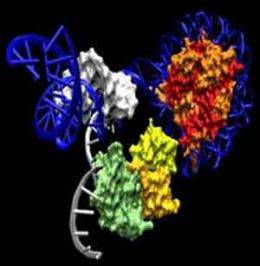How the wrong genes are repressed

The mechanism by which 'polycomb' proteins critical for embyronic stem cell function and fate are targeted to DNA has been identified by UCL scientists.
The discovery, which has implications for the fields of stem cell and tissue engineering, is detailed in research published today in the journal Molecular Cell.
A key feature of stem cells is the suppression of genes that when later switched on lead to the differentiation of the cells into specific mature cell types, such as neurons or immune cells. Polycomb proteins, first discovered in fruit flies, are known to play a critical role in the suppression of these developmental genes. PRC2 (polycomb repressive complex-2) is present in all multicellular organisms and has been shown to be important in stem cell differentiation and early embryonic development.
The study authors found that PRC2 is brought to its target genes though binding to a new class of short RNAs transcribed by RNA polymerase II. PRC2 can then methylate chromatin, preventing the activation of developmental regulator genes that would otherwise act to alter the identity of the cell.
Senior author Dr Richard Jenner, UCL Infection & Immunity, said: "We knew that different sets of genes are turned on in different cells and that polycomb proteins prevent the wrong genes from being turned on, for example polycomb prevents the activation of neuronal genes in immune cells. However, although polycomb proteins repress genes, they are actually in a poised state - some sort of gene activity seemed to be occurring.
"We wanted to find out what this activity was and our identification of these short RNAs explains this unusual gene state. Discovering that polycomb also binds to these RNAs shows how polycomb might be recruited to genes, which are then repressed to maintain the identities of different cell types. This has been a key question in the field for some time and has important implications for how we might be able to control cell fate in tissue engineering".
More information: 'Short RNAs Are Transcribed from Repressed Polycomb Target Genes and Interact with Polycomb Repressive Complex-2' is published today in Molecular Cell.
Provided by University College London
















